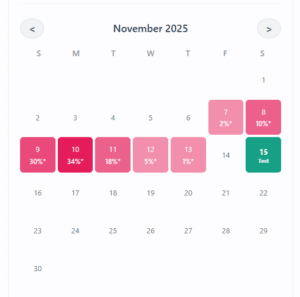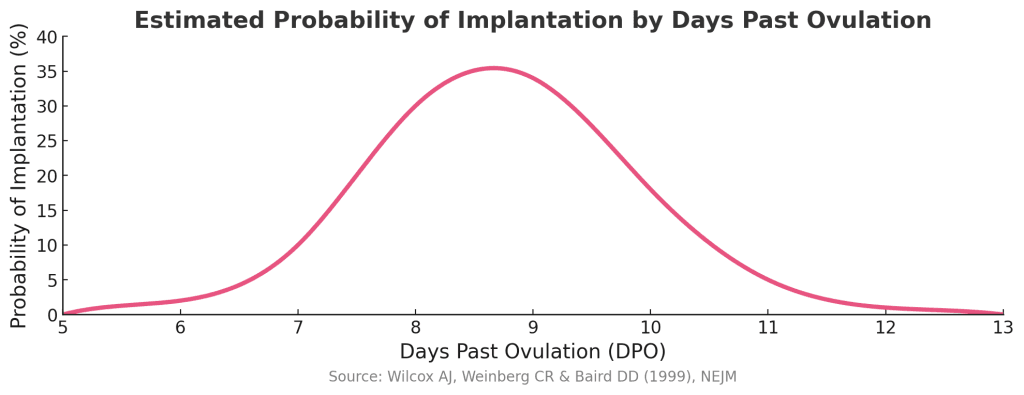Enter your last period or ovulation date to get a personalized calendar of your likely implantation window and best test day.
Estimate your implantation window
Spotting today?
Use the Implantation Bleeding Calculator to compare signs versus a period and see an estimated probability.
Calculate implantation vs period probabilityUnderstanding Implantation and Timing
Implantation is the biological process where a developing embryo, after traveling down the fallopian tube, burrows into the lining of your uterus (endometrium). This event is essential for a viable pregnancy, as it allows the embryo to connect to the maternal blood supply for oxygen and nutrients.
How Is the Implantation Window Calculated?
While every cycle is unique, the timing of implantation is biologically constrained. It cannot happen immediately after fertilization because the embryo needs time to develop into a blastocyst.
- Ovulation (Day 0): The ovary releases an egg.
- Fertilization (Day 0–1): If sperm are present, fertilization occurs in the fallopian tube within 12–24 hours.
- Travel and Division (Days 2–5): The embryo divides and travels down the tube toward the uterus.
- The Implantation Window (Days 6–12): The embryo reaches the uterus. According to landmark research published in the New England Journal of Medicine, successful implantation occurs between 6 and 12 days after ovulation, peaking around days 8–10.
Our calculator uses this clinically established window to map your personal probability curve.

Potential Signs: Implantation or PMS?
Many women look for physical signs during the "Two Week Wait." However, caution is needed: the hormone responsible for these symptoms (progesterone) is high during the second half of your cycle whether you are pregnant or not. This is why early pregnancy symptoms are often indistinguishable from PMS.
- Light Spotting ("Implantation Bleeding"): Some women experience brief spotting (pink/brown) around days 7–10. While often attributed to implantation, this can also be caused by a secondary estrogen surge or a drop in progesterone in a non-pregnant cycle.
- Cramping: Mild, prickling, or pulling sensations are reported by some women. Unlike menstrual cramps, these are usually not intense or painful.
- Breast Tenderness: Caused by high progesterone levels. This symptom is common in both early pregnancy and the days leading up to a period.
- Temperature Dip: If you track Basal Body Temperature (BBT), you may see a one-day "implantation dip." However, this pattern also appears in non-pregnant charts and is only recognized retrospectively.
Because symptoms are unreliable, we built an Implantation vs Period Calculator to help you objectively compare your specific bleeding pattern against clinical norms.

When to Take a Pregnancy Test
Implantation is the trigger that tells your body to start producing hCG (human chorionic gonadotropin). Before this moment, you are not clinically pregnant, and a test cannot be positive.
- The Delay: After implantation (e.g., on Day 9), it takes another 2–3 days for hCG levels to rise high enough to be detected in urine.
- The Recommendation: For a reliable result, wait until 14 days after ovulation (or the day of your missed period).
- The Risk of Testing Early: Testing at 10 or 11 DPO often results in a "False Negative"—you might be pregnant, but the hormone levels are simply below the test's threshold.
Understanding a Negative Test Result
Seeing a negative pregnancy test can be disheartening, especially if you tested early. It's important to remember that a negative result before the day of your missed period is not definitive. If you tested before the 14-day mark after ovulation, your body may not have produced enough of the pregnancy hormone (hCG) to be detected yet. If your period doesn't arrive as expected, it's a good idea to wait a few days and test again with your first-morning urine, when hCG levels are most concentrated.
Frequently Asked Questions
How to calculate implantation date
Start from your ovulation date, then add 6 to 12 days. The most common day is about 9 DPO. If you do not know ovulation, estimate it from your cycle length, then add 6 to 12 days. The calculator above applies this window.
When will I implant?
Most implantations happen 6 to 12 days after ovulation, with a peak around 9 DPO. Add 6 to 12 days to a known ovulation date to estimate your window.
When did I implant?
If you noted brief light spotting, it may align with implantation in the 6 to 12 DPO window. Use the calculator above to back-calculate from ovulation or cycle dates. Many pregnancies have no spotting.
When would implantation bleeding occur?
It usually occurs within 6 to 12 DPO. It is light and short. A flow that needs pads or lasts several days is more consistent with a period. Compare signs with the implantation vs period calculator.
What day is most common for implantation?
About 9 days after ovulation, within a normal range of 6 to 12 DPO.
How long after implantation should I take a pregnancy test?
hCG rises after implantation. A reliable home test is usually from the day of the missed period. For day by day odds, use the pregnancy test accuracy calculator.
Methodology and sources
What this tool estimates
This calculator shows an estimated window when implantation is most likely to occur if conception has already happened in a given cycle. It also highlights one cautious day when a home pregnancy test is more likely to be accurate. It does not predict whether conception or implantation will occur.
Core timing assumptions
The model is anchored to ovulation:
- Ovulation input: If you enter an ovulation date, the model treats that day as ovulation (day 0).
- LMP input: If you enter the first day of your last menstrual period and a cycle length, the calculator estimates ovulation as LMP plus (cycle length minus 14 days). This reflects that in many cycles the luteal phase is around 12 to 14 days, with natural variation between people and cycles.
Implantation window and relative probabilities
Daily hormone studies that track urinary hCG show that implantation is usually detected between 6 and 12 days after ovulation, with most ongoing pregnancies implanting around 8 to 10 days after ovulation.
- Window: The coloured band on the calendar runs from 6 to 12 days after the estimated ovulation date.
- Relative chance curve: The percentage labels across days 6 to 12 (for example 2%, 10%, 30%, 34%, 18%, 5%, 1%) are scaled so they sum to 100%. They form a simple bell-shaped curve with a peak around 8 to 10 days after ovulation, matching the pattern seen in implantation timing studies.
- Calendar view: Days with higher relative probabilities are shown with stronger colouring. The percentages are relative within that cycle and are not absolute chances that pregnancy will occur.
Pregnancy test day
After implantation, hCG needs time to rise high enough to be detected in urine. Patient information from clinical and public health sources advises that home pregnancy tests are more accurate from about the day a period is due and more reliable again if you test after a missed period.
- The calculator marks a “First day for accurate test” at 14 days after the estimated ovulation date. This is a cautious point where many tests perform better, although some people will test positive earlier and some only later.
How different inputs affect the dates
Because the tool is anchored to ovulation, inputs shift dates in these ways:
- Changing ovulation date directly: Moves the whole implantation window and the test day earlier or later by the same number of days.
- Changing cycle length when using LMP: A longer cycle shifts the estimated ovulation date, implantation window, and test day later in the month. A shorter cycle shifts them earlier.
- Time zone handling: Dates are treated as whole days in your local time zone. The calendar is meant as an approximate schedule rather than an hour-by-hour model.
Limits of this estimate
This tool uses typical ranges and population averages. It does not adjust for:
- cycles with very early or very late ovulation
- fertility medications, ovulation induction, or assisted reproduction timing
- health conditions that affect ovulation, implantation, or hormone levels
- differences in pregnancy test brand sensitivity or user technique
The calendar and percentages are for general education only. They are not medical advice and do not replace guidance from your doctor, midwife, or fertility specialist.
Sources
Key references that informed the timing and wording include:
- Wilcox AJ, Baird DD, Weinberg CR. Time of implantation of the conceptus and loss of pregnancy. New England Journal of Medicine, 1999. (The primary source for our implantation window data).
- Cole LA, et al. The normal variabilities of the menstrual cycle. Fertility and Sterility, 2009. (Supports our use of the standard 14-day luteal phase assumption).
- Nepomnaschy PA, et al. Urinary hCG patterns during the week following implantation. Human Reproduction, 2008. (Confirms the detection peak around 8–10 days post-ovulation).
- Jukic AM, Weinberg CR, et al. The events of early pregnancy: prying open the black box. Ultrasound in Obstetrics & Gynecology, 2011.
- Clinical Guidelines: Guidance on pregnancy testing accuracy from Cleveland Clinic and Healthdirect Australia.
Medical disclaimer
The information and calculators on this site are educational tools only. They provide statistical estimates based on published research and the details you enter.
They cannot diagnose, predict what will happen for you, or replace personalized advice from a licensed health care professional who knows your full history. Always talk with your doctor, midwife, or other qualified clinician before making decisions about your health, fertility, or pregnancy.
Never ignore, avoid, or delay seeking professional medical advice because of something you read here or a result you see in a calculator. If you think you may be having a medical emergency, call 911 in the United States or your local emergency number.
